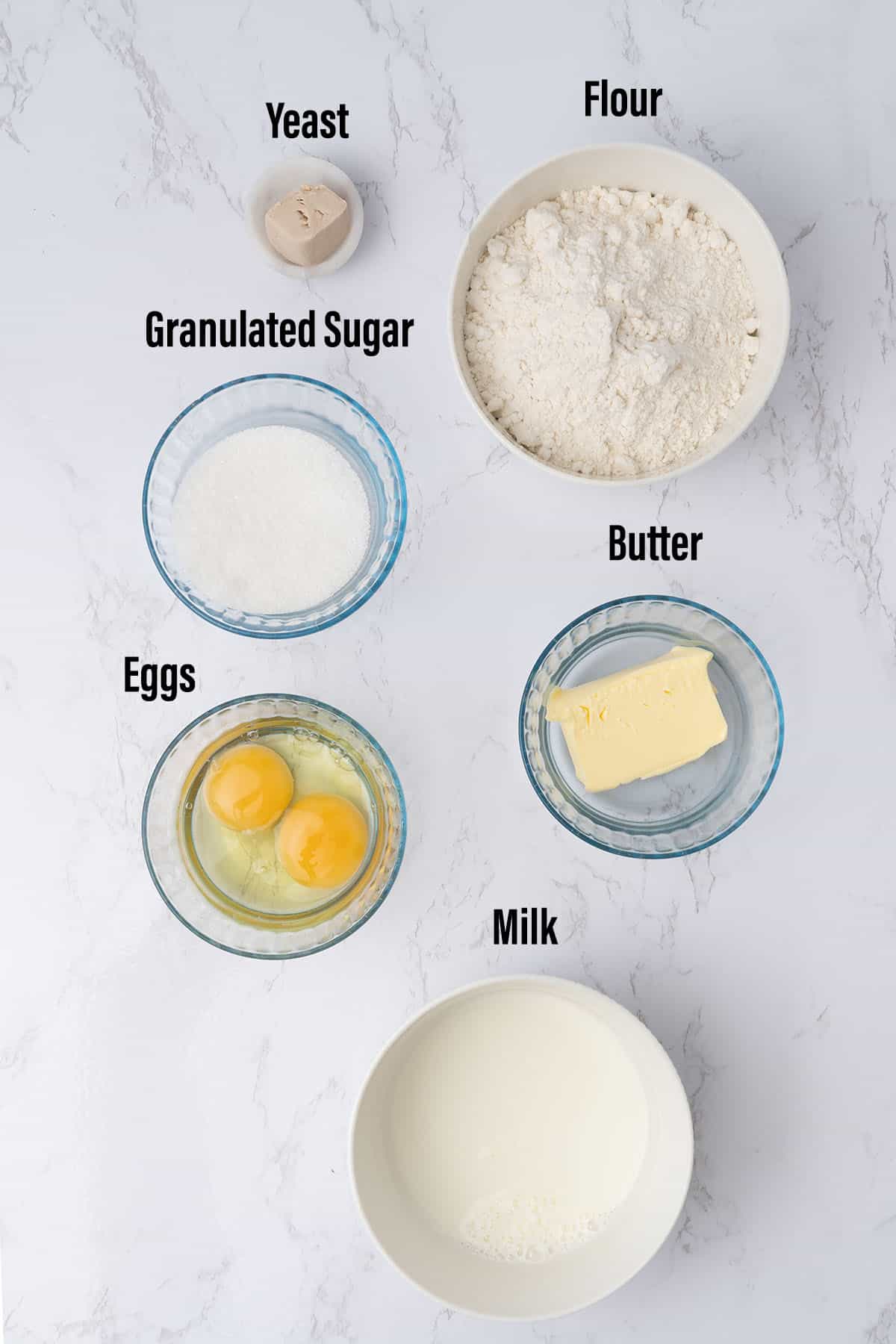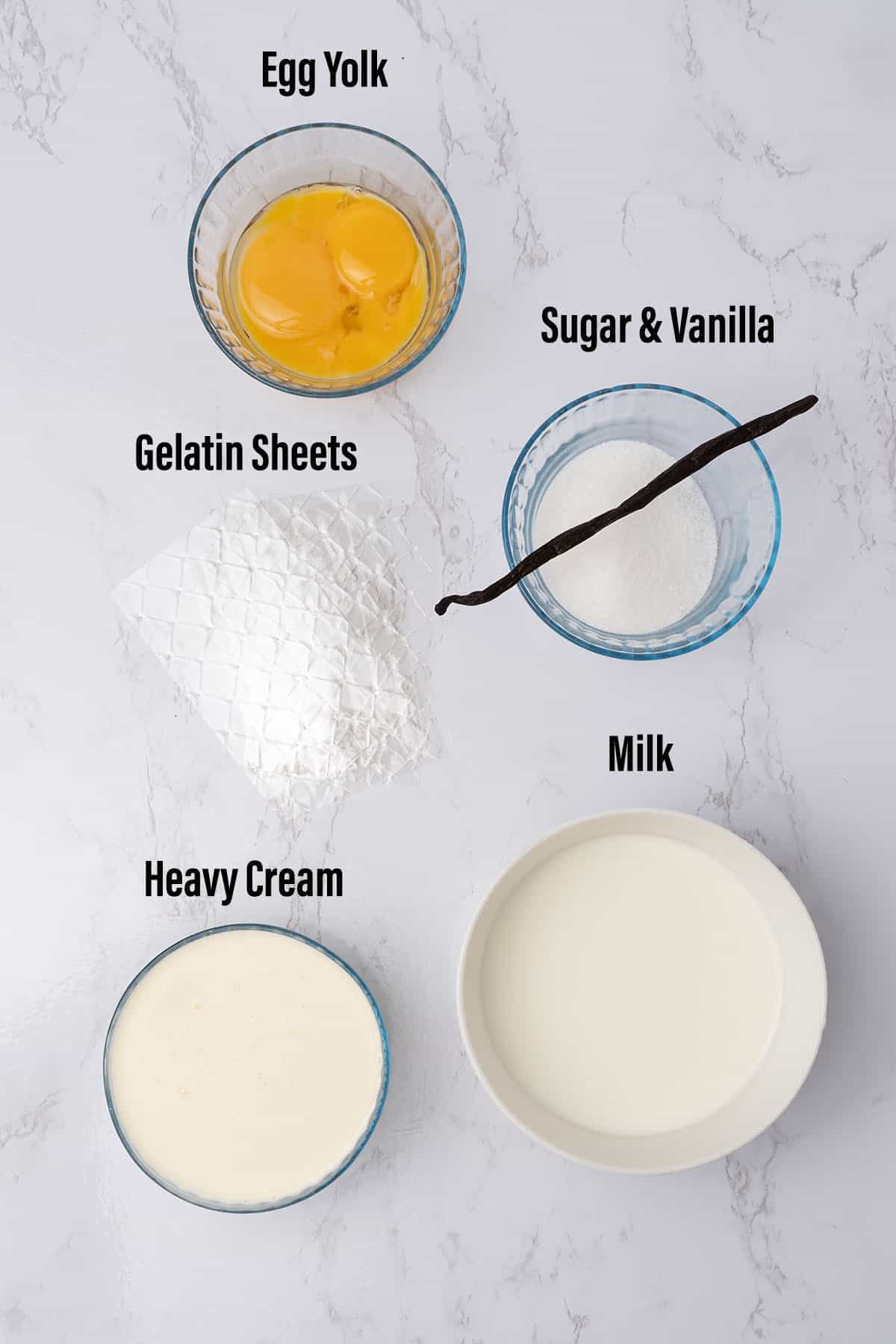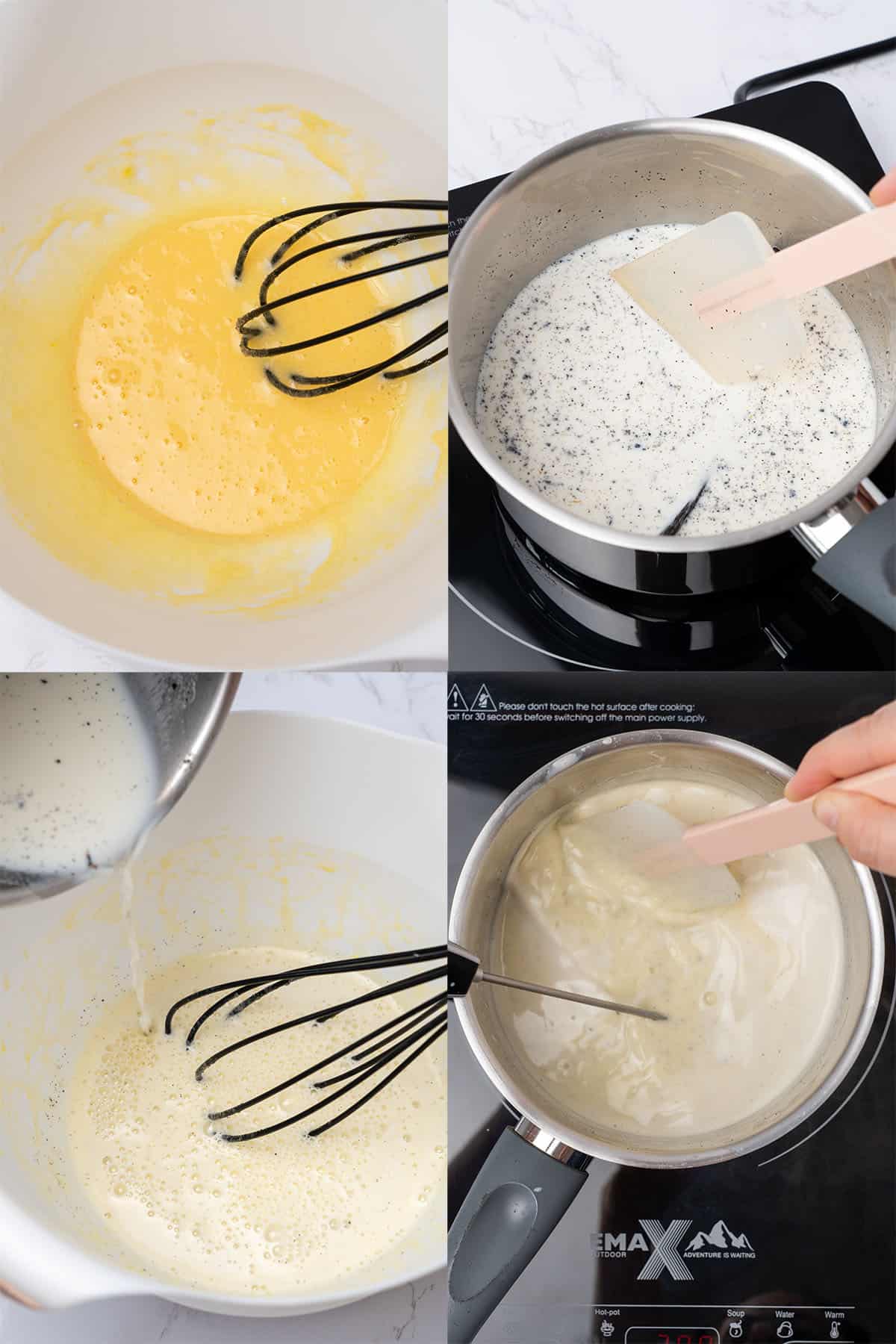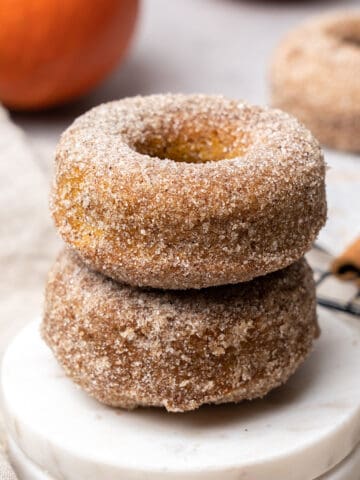There are many delicious types of cream filled donuts out there, but these delightful Bavarian cream donuts are hands down a treat that everyone will love! Made with buttery brioche donuts and then filled with a creamy, rich French vanilla cream, they are super light, flavorful, and perfect for breakfast or dessert!

Jump to:
📖 What are Bavarian Cream Donuts
Bavarian cream donuts are fried donuts made with French brioche dough and then filled with a traditional French Bavarian cream (also known as Creme Bavarois). The soft and fluffy donut dough is made with a yeast-based dough enriched with butter, eggs, milk, and sugar.
The vanilla-flavored cream is light and creamy, made with a Crème Anglaise base combined with gelatin and whipped heavy cream. Because of its soft, fluffy, and airy dough and sweet flavor, Bavarian cream donuts are an excellent option for breakfast or dessert!
🌟 Why this is the best recipe
- It is the most delicious - I use the most high-quality ingredients and techniques to make the donuts super light, fluffy, and buttery and make the cream rich and flavorful. It is undoubtedly one of the best Bavarian cream recipes you will try!
- No fancy ingredients or equipment required - All ingredients are easy to find in your local grocery store, although many may already be in your pantry!
- It is easy to follow - This detailed, step-by-step tutorial covers everything you need to know to make perfectly filled donuts. Just follow each step as written and follow my expert tips below.
- You won’t spend all day in the kitchen - The recipe itself only takes 30 minutes to prepare and with minimal effort. The longest part is waiting for the dough to proof, which you can do overnight.
- It is versatile - You can customize your donuts with various toppings and fillings, as I share in the Flavor Variations and Substitutions section below.

📝 Ingredient notes
For the donuts

- Milk - Whole milk, preferably with 3% fat content for the best flavor. The milk needs to be lukewarm.
- Sugar - A small amount of granulated sugar will help sweeten the dough.
- Yeast - I use fresh yeast in this recipe. You can also substitute with approximately 1.5 teaspoons (5g) of instant yeast. For more tips, see my guide on how to bake with yeast.
- Egg - You will need one whole egg and one egg yolk to help add moisture to the dough. Both need to be at room temperature.
- Bread flour - Use high protein content bread flour for the best results. If necessary, you can substitute with all-purpose flour, although the texture will not be as chewy.
- Salt - Salt is an essential ingredient to help balance the sweetness and enhance the flavor.
- Butter - Use unsalted butter to control the amount of salt in the recipe. I use 82% fat-content European Butter to give the donuts the best flavor. The butter must be at room temperature to be soft enough to knead into the dough. Do not use melted butter, as it will not blend in with the dough.
- Oil - You will need vegetable oil or canola oil to fry the donuts.
🛒 You’ll find detailed measurements for all ingredients in the printable version of the Recipe Card at the bottom of this post
For the Bavarian cream

- Milk - For the best results, use whole milk with a high-fat content. I use 3% milk in this recipe.
- Sugar - Plain granulated sugar works the best. See my sugar guide for the different types of sugar and how to use them in baking.
- Egg yolk - You will need the yolk of approximately three eggs.
- Vanilla extract - Pure vanilla extract gives the Bavarian cream its delicious flavor. Avoid using imitation vanilla extract. You can also use vanilla bean paste.
- Gelatin sheets - You can also substitute 6.8g of gelatin powder. See my gelatin guide for more about using gelatin sheets vs. powder.
- Heavy Cream - Use heavy whipping cream with at least 36% fat for the best taste and texture. The cream needs to be very cold before whipping it. Check my article about what is heavy cream.
🛒 You’ll find detailed measurements for all ingredients in the printable version of the Recipe Card at the bottom of this p
👩🍳 How to make this recipe
1. How to make the donuts
- Mix the sugar with the lukewarm milk. Next, sprinkle the fresh yeast on top. You will see the yeast start to foam in approximately 10 minutes.
- Place the yeast mixture into the stand mixer with a kneading dough hook attached. Add the room-temperature egg and egg yolk to the yeast and mix well.
- Then, add the flour and salt to the mixture and knead until the dough comes together.
- Next, slowly add the room-temperature butter, one chunk at a time. Knead the dough on medium-high speed for 10 minutes. Stop kneading when the dough is elastic, shiny, and no longer sticky.
- Place the dough into a bowl and cover it with plastic wrap or a kitchen towel. Let it sit at room temperature for 1-2 hours until the dough doubles in size. For the best results, let the dough rise overnight in the fridge.
- After the dough rises, press the air out. Then, gently knead the dough for a few seconds before dividing it into 12 pieces.
- Roll the 12 dough pieces into balls and place them onto a baking sheet with individual square sheets of parchment paper. To prevent sticking, sprinkle the dough with a small amount of flour.
- Cover and proof the dough a second time now at room temperature for 1-2 hours or until they double in size.
- Once the donuts have risen to a nice, puffy texture, heat the oil in a heavy-bottomed pan over medium heat until the temperature is between 347-365F / 175-185C. The ideal oil temperature for frying donuts is 356F/180C.
- Fry the donuts in batches, giving each piece sufficient space around it. Fry on each side for approximately two minutes or until the color turns a golden brown.
- Move the fried donuts to a wire rack lined with paper towels to soak up any extra oil.
💡 Top Tip: It is highly recommended to place the dough in the fridge overnight for the first rise. The cold dough will be less sticky and much easier to work with versus soft room-temperature dough.

2. How to make Bavarian cream
- Soak the gelatin sheets in cold water.
- Using a hand whisk, mix the sugar, egg yolk, and vanilla in a large bowl for 1-2 minutes until slightly fluffy.
- Bring the milk to a simmer over medium heat in a saucepan. Do not let it boil.
- While vigorously whisking the egg yolk mixture, slowly pour in the warm milk mixture to temper the egg yolks.
- Pour the combined mixture into the saucepan. Cook over medium heat until the temperature reaches 180F / 82C.
- Immediately remove the custard mixture from the heat to prevent curdling.
- Squeeze the excess water from the gelatin sheets, then gently stir the sheets into the hot cream.
- If using gelatin powder, mix the powder with one tablespoon of cold water. Mix it into the warm custard as soon as it thickens into a paste.
- Place the custard into a shallow bowl or container and cover it with plastic wrap. Make sure the plastic wrap is touching the custard to prevent skin from forming on top. Let it sit for one hour until it reaches room temperature.
- Whip the cold heavy cream until it starts to form stiff peaks. Do not overwhip.
- Gently fold the whipped heavy cream into the custard using a rubber spatula in 2-3 portions.
💡 Top Tip: Whip the cream until the peaks stand straight up when the whisk is lifted, and the tips don’t curl. Stop whipping immediately when it reaches this point, or you risk overwhipping the cream and making it too stiff to combine with the custard.


3. How to fill the donuts
- Once the donuts have cooled to room temperature, poke a small hole in one side. A chopstick or knife works well for this step. Make sure the opening is wide enough to add the filling.
- Add the Bavarian cream filling into a piping bag with a round tip.
- Insert the piping bag tip into the hole and gently squeeze the cream filling inside.
- Add your favorite toppings if desired, and serve fresh.
💡 Top Tip: Fill the donut slowly to allow the cream to reach all the air pockets in the donut.

🥣 Equipment Notes
Use a digital scale for the most accurate and consistent measurements. Likewise, a digital thermometer will help ensure the oil is at the proper temperature for frying the donuts.
You will need a hand whisk to mix the ingredients and temper the egg yolks. A rubber spatula is necessary to fold the whipped cream into the custard.
A stand mixer makes kneading the dough much easier and faster than kneading by hand! If using the rolling and cutting out method to make donuts with a hole in the middle, you will need a rolling pin to press the dough to the appropriate thickness.

✨ Flavor variations & Substitutions
These Bavarian Cream donuts are delicious as-is, but there are several other ways to enjoy them! Here are just a few of the different flavors and topping variations you can try:
Chocolate Bavarian Donuts: Stir in melted dark chocolate as in my chocolate creameux recipe to make chocolate Bavarian Cream donuts.
With other fillings: Swap out the Bavarian cream for a pastry cream filling or different flavors such as lemon curd, strawberry compote, or even Nutella!
With toppings: Toss the donuts in granulated sugar, powdered sugar, or drizzle them with glaze before serving.
Using dry yeast: Substitute the fresh yeast with instant dry yeast. However, it is important to check the packaging for the correct amount of active dry yeast to substitute. Check my yeast guide for instructions.
Without eggs: If you have an egg allergy, use one of the available egg substitutes to make this Bavarian donut recipe. However, since the egg is a critical component, you will likely need to make other adjustments to get the same flavor and texture.
🎓 Expert tips
- The eggs, milk, and butter must all be at room temperature for the ingredients to emulsify properly when making the donuts.
- You must always activate the yeast first until it is foamy. Activating the yeast will require that your kitchen must be nice and warm. However, avoid placing the mixture near direct heat or sunlight.
- When kneading the dough, do not attempt to adjust the ingredients or add more flour to speed up the process. If the dough sticks, continue kneading until it reaches the gluten window and can pass the windowpane test.
- For ease of handling the dough, do the first proofing overnight in the refrigerator. Do not skip the second proofing, as it is necessary to give the donuts the perfect rise and texture.
- Monitor the oil temperature to ensure it is not too hot or too cool. The oil that is too hot will burn the outside of the donuts while the inside remains raw and undercooked. Oil that is too cool will soak up too much oil while the inside remains raw and undercooked.
- Add enough oil to the pan to allow the donuts to float without touching the bottom. This amount will vary depending on what type of pan you use. You can also use a deep fryer if you have one.
- When making Bavarian cream, use a digital thermometer to check the temperature of the combined warm milk and egg mixture. Do not let the heat exceed 180F / 82C, or the egg will curdle.
- For the best results, fold the whipped cream into the custard in portions versus all at once.
❓Recipe FAQs
Although the donuts are best when you serve them the same day, you can store them in the refrigerator in an airtight container for up to three days.
I do not recommend freezing the donuts. However, you can freeze the unfilled donuts for up to a month. Once completely cooled, wrap each donut in aluminum foil and place them in the freezer. To thaw, let them sit at room temperature.
You can use agar agar or cornstarch as a gelatin substitute in the Bavarian cream for vegan diets, however, these substiutes work differently and probably you will need to test and adjust the recipe yourself.
Since Bavarian cream contains eggs, whipped cream and dairy, it has a limited shelf life, few days only. To extend the shelf life, always place it in the refrigerator when not in use and serve cold.
You can make baked Bavarian cream doughnuts in the oven at 350F / 180C for approximately 15-20 minutes. However, they will be less crispy on the outside and not have a deep-fried flavor.
Technically, yes. However, it will not have the same golden brown color or delicious deep-fried flavor!
🍩 More Donut recipes

Bavarian Cream Donuts
Equipment
- Digital scale
Ingredients
Donuts
- 110 g (½ cups) Whole milk lukewarm
- 50 g (¼ cups) Granulated sugar
- 12.5 g Fresh yeast Can be substituted with 5g (1,5 teaspoons) instant yeast
- 1 Egg yolk room temperature
- 1 Egg room temperature
- 250 g (2 cups) Bread flour High protein content flour. Can be substituted with All purpose flour
- ¼ teaspoon Salt
- 120 g (½ cups) Unsalted butter room temperature, soft
- 1.5 liter (6 cups) Vegetable or Canola oil for frying
Bavarian Cream
- 250 g (1 cups) Whole milk 3% fat
- 75 g (⅓ cups) Granulated sugar
- 60 g (¼ cups) Egg yolk approx. yolk of 3 eggs
- 2 teaspoons Vanilla extract
- 4 Gelatin sheets or 6.8g (1,5 teaspoon) gelatin powder
- 230 g (1 cups) Heavy cream 36% fat, use it very cold
US customary cup measurement is an indicative figure only. Measure the ingredients with a digital scale by weight (gram). Baking is art but also science which requires precision and accuracy.
Instructions
For the donuts
- Start with mixing sugar with lukewarm milk then sprinkle yeast on top. Make sure the kitchen is nice and warm, and in 10 minutes the yeast should foam.
- Place the yeast mixture into your Stand mixer with the kneading hook on, then mix it together with the egg and egg yolk.
- Mix in dry ingredients; flour, and salt, and start kneading until the dough comes together.
- Slowly start to add in room temperature (soft) butter chunks piece by piece. Knead the dough for another 10 minutes on medium high speed until the dough becomes elastic and shiny and not sticky any longer.
- Move the dough into a bowl, cover it with plastic wrap or a tea towel. Let it rise ideally in the fridge overnight or at room temperature for 1-2 hours.
- After the dough has risen, knock the air out, gently knead the dough for a few seconds and divide it into 12 using a digital scale.
- Form 12 balls with your hand and place them into square sheets of baking paper. Use a small amount of extra flour while shaping the dough, if needed.
- Proof the dough for the second time now at room temperature. Proofing might take 1-2h depending on the temperature of your kitchen. Chose a warm spot but avoid direct heat and sunlight.
- Once the donuts are nicely puffed up, heat vegetable oil in a heavy-bottomed pan over medium heat. The ideal oil temperature for baking donuts is 180C/356F or between 175-185C / 347-365F. Use a thermometer.
- Depending on the size of your pan, place 3-4 donuts in the oil at a time, leaving enough space around them. Fry the donuts on each side for about 2 minutes or until nice and brown.
- Place the fried donuts on a wire rack lined with paper towels to soak up any excess oil. Let them come to room temperature.
For the Bavarian cream
- Soak the gelatin sheets in cold water.
- In a large enough bowl, with the help of a Hand whisk, whisk together sugar, egg yolk, and vanilla until slightly fluffy for about 1-2 minutes.
- Bring milk to simmering in a saucepan on medium heat then pour the warm milk mixture over the egg yolk mixture slowly while whisking vigorously with a Hand whisk.
- Pour the mixture back into the saucepan and cook on medium heat until the temperature reached 82C / 180F. Remove the cream from the stove as soon as the cream reaches the desired temperature.
- Squeeze excess water from the gelatin sheets and stir them into the hot cream. Alternatively, if using gelatin powder, mix together the gelatin powder with 1 tablespoon of cold water then when thickened into a paste, immediately mix into the warm custard.
- Place the custard into a shallow bowl or container and cover the entire surface with plastic wrap to avoid skin forming on top. Let it come to room temperature in about an hour. Do not let it chill as the gelatin will set too hard.
- Once the custard is at room temperature, whip very cold heavy cream until early stiff peaks. Do not overbeat. Fold the whipped cream very gently into the custard in 2-3x portions.
- You can use this Bavarian cream straight away to fill your room temperature donuts or let it chill for 2-3 hours for the gelatin to set.
- Store the unfilled donuts in an air-tight container at room temperature for 1-2 days. If filled, store them refrigerated for 1-2 days.
Notes
- Use always unsalted butter in baking, in this recipe butter needs to be at room temperature so soft enough to be able to knead into the dough when making the donuts.
- Fresh or Dried yeast can be used. Please check my baking guide for more details on how to bake with yeast.
- Use the milk, butter and egg at room temperature in order for the ingredients to properly emulsify.
- Since rum donut is effectively a sweet bread, use high protein content bread flour
- High-fat content milk and pure vanilla extract are the heart of making Bavarian Cream.
- When making the Bavarian cream, you will want to use high fat content heavy cream (36%) and it has to be very cold before whipping up.
- I am using 4 gelatin sheets that can be substituted with 6.8g gelatin powder. Check my gelatin guide to learn more about how to with gelatin sheets vs powder.
- For activating the yeast (whether it is dried or fresh), make sure that the milk is lukewarm and your kitchen is also nice and warm.
- You will knead the dough for about 10 minutes in a stand mixer. The dough is ready when it is shiny, elastic, and does not stick to your fingers any longer. Do not add more flour to the dough. If it sticks too much, continue kneading.
- The first proofing ideally should happen in the fridge overnight for the best flavor and texture. It will also mean that you work with cold dough when shaping the donuts, which is less sticky and easier to shape.
- Second proofing is necessary for the perfect rise = fluffy texture
- The oil temperature is critical, use a thermometer. Too hot? It will burn the donuts and they might stay raw in the middle. Too cold? The donuts will soak in too much oil and, again, might stay raw in the middle.
- Do not heat the custard further than 82C / 180F, as the egg will curdle.
- Make sure to let the custard come to room temperature before folding the whipped heavy cream in.
- When whipping the cream, you will want to reach early stiff peaks; stiff peaks (or firm peaks) stand straight up when the mixer is lifted, and the tips don't curl. However, stop whipping as soon as you reach stiff peaks, as once you over-whip the cream, it will become very stiff, and the texture won't be smooth enough to fold in with the custard.






PC
Love your site and content!